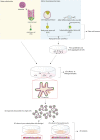Organoids: a promising new in vitro platform in livestock and veterinary research
- PMID: 33691792
- PMCID: PMC7943711
- DOI: 10.1186/s13567-021-00904-2
Organoids: a promising new in vitro platform in livestock and veterinary research
Abstract
Organoids are self-organizing, self-renewing three-dimensional cellular structures that resemble organs in structure and function. They can be derived from adult stem cells, embryonic stem cells, or induced pluripotent stem cells. They contain most of the relevant cell types with a topology and cell-to-cell interactions resembling that of the in vivo tissue. The widespread and increasing adoption of organoid-based technologies in human biomedical research is testament to their enormous potential in basic, translational- and applied-research. In a similar fashion there appear to be ample possibilities for research applications of organoids from livestock and companion animals. Furthermore, organoids as in vitro models offer a great possibility to reduce the use of experimental animals. Here, we provide an overview of studies on organoids in livestock and companion animal species, with focus on the methods developed for organoids from a variety of tissues/organs from various animal species and on the applications in veterinary research. Current limitations, and ongoing research to address these limitations, are discussed. Further, we elaborate on a number of fields of research in animal nutrition, host-microbe interactions, animal breeding and genomics, and animal biotechnology, in which organoids may have great potential as an in vitro research tool.
Keywords: Animal breeding and genomics; Animal health; Animal nutrition; Host-microbe interaction; In vitro model; Organoids; Stem cell research; Veterinary research.
Conflict of interest statement
The authors declare that they have no competing interests.
Figures


References
-
- Eiraku M, Watanabe K, Matsuo-Takasaki M, Kawada M, Yonemura S, Matsumura M, Wataya T, Nishiyama A, Muguruma K, Sasai Y. Self-organized formation of polarized cortical tissues from ESCs and its active manipulation by extrinsic signals. Cell Stem Cell. 2008;3:519–532. doi: 10.1016/j.stem.2008.09.002. - DOI - PubMed
Publication types
MeSH terms
Grants and funding
LinkOut - more resources
Full Text Sources
Other Literature Sources
Medical

